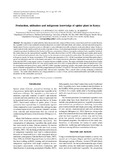Production, utilisation and indigenous knowledge of spider plant in Kenya

View/
Date
2013Author
Onyango, CM
Kunyanga, CN
Ontita, EG
Narla, RD
Kimenju, JW
Language
enMetadata
Show full item recordAbstract
The importance of spider plant has been discussed in the context of biodiversity conservation and food security because
the vegetable is rich in micronutrients and phytochemicals associated with antioxidant, anti-malaria, and anti-microbial properties.
Spider plant (Cleome gynandra) exists as cultivated or semi-cultivated crop with ecological, social and cultural values. It plays a
significant role in the nutrition and food security of people in Kenya. A structured questionnaire was administered to ninety randomly
sampled respondents distributed in the Western and Nyanza communities of Kenya. Among the traditional leafy vegetables identified,
the spider plant was the most preferred vegetable. The study observed that over 98% of the respondents grow spider plant mainly
for its nutritional and medicinal value. Sun drying was the main preservation method for spider plant. The spider plant was reported
to be grown mainly for home consumption (57%) and income generation (43%). All the respondents indicated that spider plant is
grown for subsistence and 70% of the farmers allocated 5-30% of their land for its cultivation. Spider plant cultivation was reported
to be rain fed (58%) using organic sources of manure that are available on-farm. The major constraints facing production of spider
plant included mainly insect pests (56%) and lack of quality seed (20%). 86% of spider plant was sold at open air markets and < 10%
in supermarkets and green grocery stores with 80% of the consumers preferring varieties with purple stems and leaf petioles. The
prices of bundles ranging between 300-500 g ranged between US dollar 0.19 and 0.25. The study showed that there is widespread and
intense cultivation of spider plant amongst other African leafy vegetables. This is mainly done as home gardening or intercrop
systems. The spider plant, therefore, has a huge potential as a source of food, and has nutritional benefits and health promoting
properties for the communities growing it.
